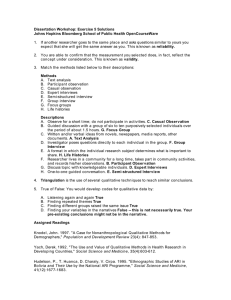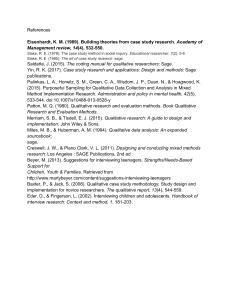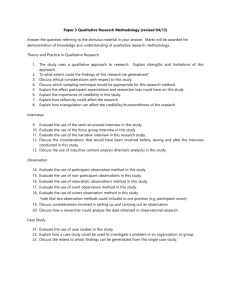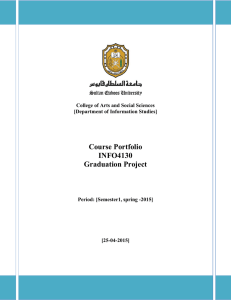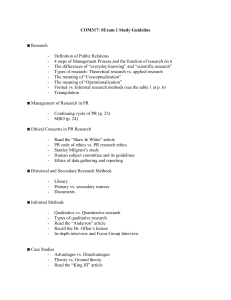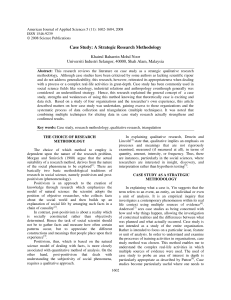Dissertation Workshop: Exercise 5
advertisement
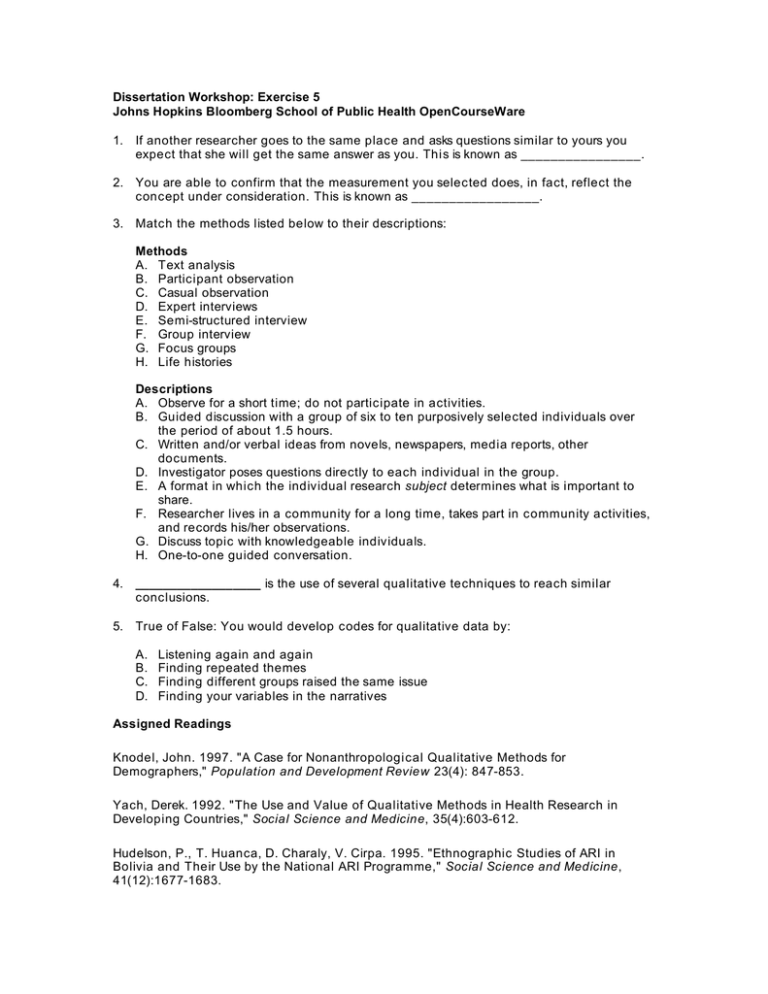
Dissertation Workshop: Exercise 5 Johns Hopkins Bloomberg School of Public Health OpenCourseWare 1. If another researcher goes to the same place and asks questions similar to yours you expect that she will get the same answer as you. This is known as ________________. 2. You are able to confirm that the measurement you selected does, in fact, reflect the concept under consideration. This is known as _________________. 3. Match the methods listed below to their descriptions: Methods A. Text analysis B. Participant observation C. Casual observation D. Expert interviews E. Semi-structured interview F. Group interview G. Focus groups H. Life histories Descriptions A. Observe for a short time; do not participate in activities. B. Guided discussion with a group of six to ten purposively selected individuals over the period of about 1.5 hours. C. Written and/or verbal ideas from novels, newspapers, media reports, other documents. D. Investigator poses questions directly to each individual in the group. E. A format in which the individual research subject determines what is important to share. F. Researcher lives in a community for a long time, takes part in community activities, and records his/her observations. G. Discuss topic with knowledgeable individuals. H. One-to-one guided conversation. 4. __________________ is the use of several qualitative techniques to reach similar conclusions. 5. True of False: You would develop codes for qualitative data by: A. B. C. D. Listening again and again Finding repeated themes Finding different groups raised the same issue Finding your variables in the narratives Assigned Readings Knodel, John. 1997. "A Case for Nonanthropological Qualitative Methods for Demographers," Population and Development Review 23(4): 847-853. Yach, Derek. 1992. "The Use and Value of Qualitative Methods in Health Research in Developing Countries," Social Science and Medicine, 35(4):603-612. Hudelson, P., T. Huanca, D. Charaly, V. Cirpa. 1995. "Ethnographic Studies of ARI in Bolivia and Their Use by the National ARI Programme," Social Science and Medicine, 41(12):1677-1683. Dawson, S, L Manderson, and V.L. Tallo. 1993. "Analysis of the Results" in A Manual for the Use of Focus Groups. WHO Social and Economic Research (SER) UNDP/World Bank/WHO Special Programme for Research and Training in Tropical Diseases (TDR). Boston, MA: International Nutrition Foundation for Developing Countries (INFDC), pp. 39-47. Recommended Readings Basch, Charles E. 1987. "Focus Group Interview: An Underutilized Research Technique for Improving Theory and Practice in Health Education," Health Education Quarterly 14(4):411-448. Bryman, Alan and Robert G. Burgess. 1994. Analyzing Qualitative Data. London:Routledge. Krueger, Richard A. 1994. Focus Groups: A Practical guide for Applied Research. Second Edition. Thousand Oaks: Sage. Riessman, Catherine K. 1993. Narrative Analysis. London: Sage Publications. Silverman, David. 1993. Interpreting Qualitative Data: Methods for Analysing Talk, Text and Interaction. London: Sage Publications. Whyte, William Foote. 1997. Creative Problem Solving in the Field. Walnut Creek: AltaMira Press.
